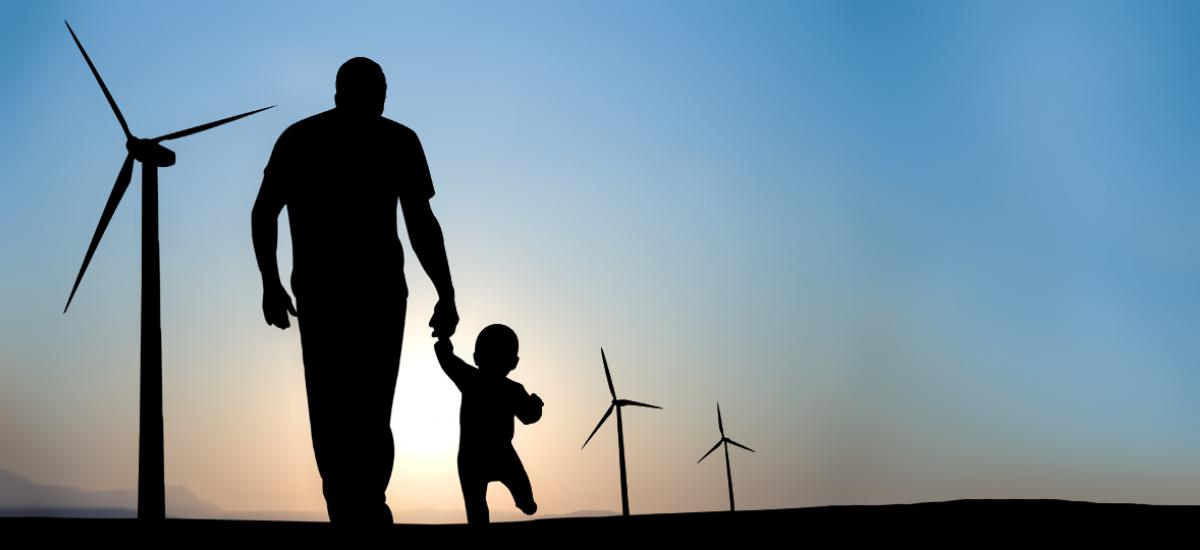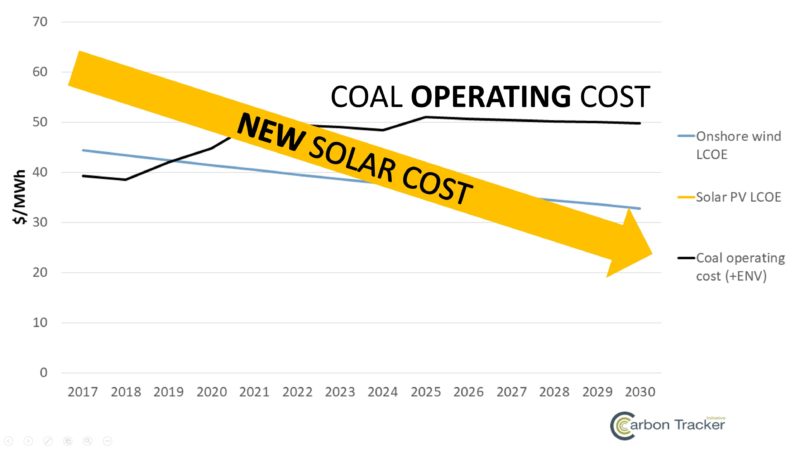Sustainable energy systems are now a better commercial bet than carbon-fuelled ones. But consumers must still consume less of it
A very encouraging report from futurist Ramez Naam, on how we are heading for a new phase in renewables energy - where they will actually be disruptive to existing fossil electricity.
The first phase, from 1980-2015, was “policy dependent”, says Naam. “Solar reached 1% of global electricity. Wind reached perhaps 4%. The world spend hundreds of billions of dollars subsidizing clean energy, and seemingly got nothing.”
The second phase is when renewables started to become competitive - because the price had been driven down by policy investments over these decades (so, not nothing). A graph like this speaks for itself:
The cost of solar and wind is dropping below the cost of fossil fuel electricity around the world. Each blue or orange circle reflects one solar or wind project. The heavy lines reflect global weighted average prices of solar and wind. Source: IRENA
The third phase is imminent - when renewable is so cheap it begins to shut down, on price, current fossil fuel generation.
Naam explains below (blog link):
Now, after decades of subsidizing solar and wind, we’re on the verge of a new, radically different point in history – the point at which building new solar or wind power (or new energy storage systems, in some cases), is cheaper than the cost of continuing to operate existing coal- or gas-fueled power plants.
Dubious? Consider the following:
Graph 2
NextEra CEO: Cheaper to Build Solar & Wind Than Operate Existing Coal by the Early 2020s: In January 2018, NextEra CEO Jim Robo told investors that by the early 2020s, it would be cheaper to build new solar and wind power than to operate the utility’s fleet of existing coal power plants.
NIPSCO: Cheapest Option is to Go from 65% Coal-powered to Zero – and Replace it With Solar, Wind, and Storage. In October of 2018, a utility in Northern Indiana, NIPSCO, reached Jim Robo’s prophesied point years ahead of schedule, when it submitted a 5 year resource plan that would take the region from being 65% coal powered in 2018 to just 15% coal powered in 2023, and 0% coal powered in 2028, and replace virtually all of that coal power with a mix of solar, wind, storage, and flexible demand. Bear in mind that NIPSCO is in a region with mediocre sun, pretty good but not amazing wind, and which voted for Donald Trump by 19 points. Admittedly, this is with prices of solar and wind which are still somewhat subsidized in the US. But not tremendously so, as the US federal solar and wind tax credits (the ITC and PTC) are winding down in exactly this same period.
2019: Florida Power and Light: Cheaper to Build New Solar + Storage Than Operate Existing Gas Plants. In March of 2019, Florida Power and Light said it would retire two aging natural gas plants, and replace them with a combination of energy efficiency and the world’s largest (so far) battery, which it will use to charge with solar power during the day to deliver during the evening peak.
CarbonTracker – New Wind and Solar Cheaper than Existing Coal and Gas in the US, China, and India by the mid-2020s. Meanwhile, think tank CarbonTracker has been quietly pumping out reports showing that in country after country, new solar and wind are headed for prices cheaper than the operational cost of existing coal and gas. Consider this chart (slightly modified by yours truly) of new solar and wind cost in the US vs coal operational cost (see Graph 2 abov
See CarbonTracker’s report on the disruption of Coal in the US for more: No Country for Coal Gen. Or, more importantly, consider what CarbonTracker forecasts for China: That new solar and wind will be cheaper than the operating cost of existing Chinese coal power plants by the 2020s.See more at CarbonTracker’s report on China’s coal fleet, “NoWhere to Hide“
McKinsey: New Solar and Wind Cheaper than Existing Coal and Gas… Pretty Much Everywhere by 2030.
Finally, if reports from CarbonTracker, or announcements by actual utilities aren’t enough, consider McKinsey’s assessment from its Global Energy Perspective 2019. In the chart below (with a bit of help from me), McKinsey shows that on almost every continent, and particularly in China and India, where energy demand has the most to grow, new solar and wind are cheaper than existing coal and gas by 2030. And often much sooner.
We’ve gone from Phase 2 to Phase 3 much more rapidly than we went from Phase 1 to Phase 2. Why? Because solar and wind power had to drop by a factor of nearly 10 in price – from 60 cents/kwh for new electricity to roughly 6 cents/kwh for new electricity – to move from their early days to being competitive for new power.
But they only have to drop by another factor of 2 or 3 to move from being competitive for new power to being cheaper than the operating cost of existing coal and gas. The “competitive zone” is much narrower and faster to pass through than the long history of subsidized prices leading up to the first fair market competition.
More here. What Naam’s story illustrates is that decades of at least some collective/state commitment to a new model of energy production has been going on - though of course we can ask whether public subsidy of private enterprise has gotten us there as quickly or as comprehensively as other models might have.
But here we are - with what looks like, even under the current capitalist system, a clear investment and profit incentive to move our energy production into post-carbon, and total sustainability.
This leaves the massive lifestyle question of whether we can address our lifestyle consumption of energy as effectively - some scenarios think we can. See this Wired article, based on this paper:
An international team of scientists has developed a global scenario called Low Energy Demand, arguing that humanity’s appetite for things like electric cars and cellphones, as well as the development of better building standards, can drive a revolution in efficiency that could help lower energy demand and encourage the proliferation of renewable energy. The researchers claim that if several trends fall into place, we’d be able to make the idealistic goal set by the Paris Climate Agreement to keep global temperatures from rising more than 1.5 degrees C.
This is how the researchers went about it. They identified major drivers of change in energy use, for example cities becoming test beds for innovations like the sharing economy. This is broken down into more specific trends, like the rise of shared electric vehicle fleets. “If everybody buysan electric car, well then you have to wait 12, 14 years for innovations to be rolled out into the marketplace, because people will not prematurely sell their car or scrap it,” says Grubler. “But in a car-sharing scheme, or shared mobility, we use these assets so much that it's actually natural to replace these assets very regularly.”
This brings rapid innovation. And say you've got solar panels at home to charge your electric car. Not only can you send that energy into the grid when you're not at home, but the battery in your electric car can store energy for someone else to tap into. You're no longer just a consumer of energy, but an active participant in the dynamics of the grid.
Or take mobile phones. Now in the hands of billions people, users want their phones to do more, to replace more energy-hungry devices, like TVs. They want them to be more energy efficient. Those kinds of market forces—or consumerism, depending how you look at it—could in a way drive down energy usage.
The researchers then reviewed studies that showed what services humans would need to raise their living standards, particularly in the global south. "At this stage, we look at given these rising activity levels, how can we provide for those with dramatically less energy?" says Charlie Wilson, a coauthor on the paper and climate change scientist at the Tyndall Centre for Climate Change Research in the UK. "And part of the answer is technologies can become much more energy efficient."
Using those inputs, they could calculate energy demand in the coming decades. “Then," Wilson says, "we used a global model of the energy system to work out well how can we meet that energy demand in 2050," using strategies like renewables. "That gives us then the emissions which we could work out and test whether they were consistent with our 1.5 degree C target.”
They were—even with a population that could grow to over 9 billion, a factor this scenario considered. “All other scenarios predict ever increasing energy demand,” says Grubler. “This scenario actually predicts a declining energy demand, despite having vast increases in activities. People travel more, eat better, have more material well being and wealth, but in a more efficient, organizational way.”
…This scenario teases apart not just the future of technological innovation, but attitude innovation. The abandonment of the let’s-all-own-cars-and-sit-in-them-in-traffic-alone model in favor of car sharing. “It does require an enormous, if you like, openness to innovation in our daily lives, as well as in the technological and infrastructural systems which provide the useful services we consume in our daily lives,” Wilson says.




